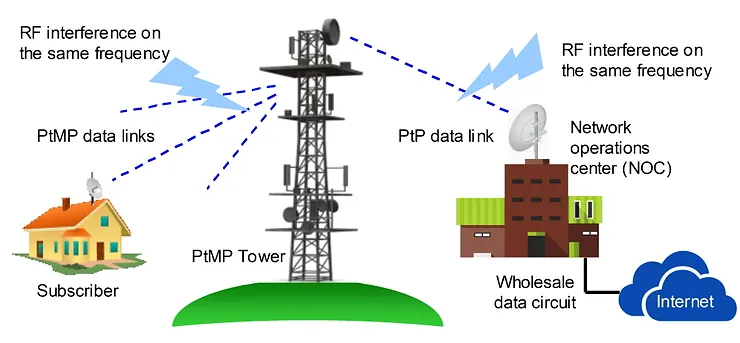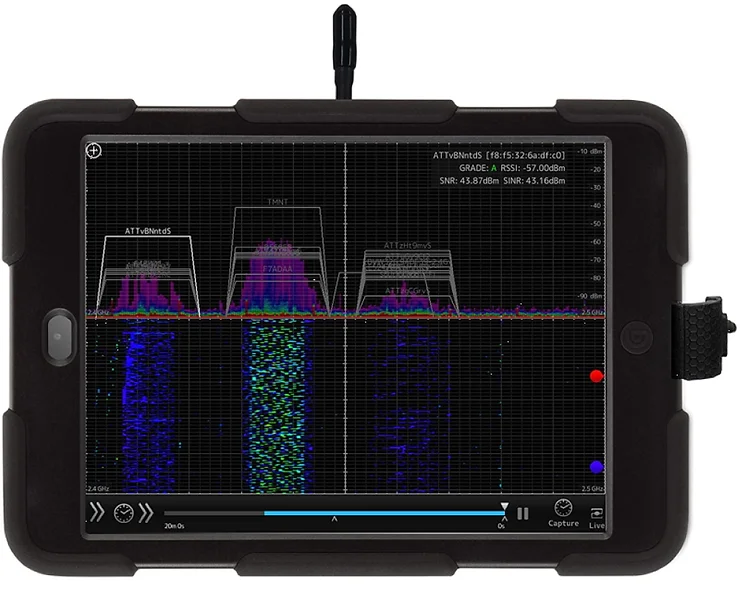Many WISP wireless networks will be installed using low cost unlicensed frequency equipment. Each wireless communications link will be subject to interference from other devices that use the same frequencies.

Unlicensed Radio Frequencies Used by WISP’s
The 2.4GHz unlicensed band has a lot of #interference however the 5GHz unlicensed band is much broader with more channels available and so it is possible to find unused RF (radio frequency) channels in that band.
What is Radio Frequency Interference?
Unwanted transmissions are received as noise and so the receiver has to separate the wanted signal from the unwanted noise. The noise is the interference that causes the reduction of the #signal to #noise ratio in the wireless receiver because the background interference strength is measured in relative to the strength of the wanted signal. As the background noise increases, the signal-to-noise ratio reduces, which makes it harder for the receiver to separate the data transmission from the noise. When this occurs the IEEE802.11 standard has design features to attempt transmission at a lower data rate. Both the transmitter and receiver switch to a lower data rate in order to maintain #communications. As the noise interference increases the data rates switch to lower and lower speeds until the noise level is equal to the signal level and communications is no longer possible. Conversely a high signal to noise ratio means that the received signal is very strong in relation to the background RF noise and can support a high data rate.

Spectrum Analyzer
“Cordless phones and wireless security cameras are the worst interference offenders.”
Use a #spectrum #analyzer to investigate and identify unlicensed band frequencies that have less interference. When the #WISP installs the #wireless equipment a scan should be made across the unlicensed frequency spectrum for other sources of #radiofrequency radiation that might interfere with the WISP’s wireless link. The spectrum analyzer will detect transmissions from devices such as cordless phones and wireless security cameras, which are the worst interference offenders. RF spectrum analyzers that cover the 2.4GHz and 5GHz bands are quite expensive, however low-cost portable products that use a popular tablet are available like the one shown.

Reducing Radio Frequency Interference
The WISP can configure the wireless equipment to use the frequency with the least interference. It may be possible that changing the link frequency solves the interference problem. #Rural areas will have much less interference than #urban areas.
In addition to changing the transmission frequency to avoid interference, a second solution is to use a very high gain directional parabolic antenna for point-to-point links that will reduce interference from sources that are transmitting around the antenna being used for communications. This is because the beam width is very narrow with a high gain antenna so the wireless only receives RF signals that are within the narrow beam path. The best antenna combination for PtMP is to use a high gain parabolic antenna with the CPE wireless and a sector or beam-forming antenna with the PtMP wireless.
“Employing the two methods described will solve most RF interference problems.”
Employing the two methods described will solve most RF interference problems.
In the cases where interference prevents data transmission then the alternative is to pay to use a licensed frequency. Government agencies, such as the FCC in the USA, are responsible for the allocation of licensed frequencies and the sale of licenses. A license will usually require an annual payment to operate on the frequency allocated. The advantage of using a licensed frequency is that if the licensee has a problem with interference then a complaint can be filed with the licensing authority. An additional cost of using a licensed frequency is that the wireless equipment is more expensive than equipment for unlicensed frequencies as the manufacturing volume is very small.
Minimizing Interference is an on-going Task
“The WISP has to maintain continuous vigilance.”
The WISP has to maintain continuous vigilance of all wireless links because as time passes other people will install equipment, which will interfere with the WISP’s wireless link. Monitoring the equipment that is part of the wireless link using SNMP will provide information about the ongoing quality of the link. Keep a log of the signal to noise ratio of the wireless link and watch for deterioration, which may be an indication of interference from another source. In the worst case the link will stop working without explanation due to interference. When the WISP goes to the tower site to investigate any link connection problem a portable radio frequency spectrum analyzer should be included in the toolkit to scan for interference.
______________________________________________________________________
Readers are invited to share this information with others. If any reader has a question regarding this information please contact us via our contact page.
